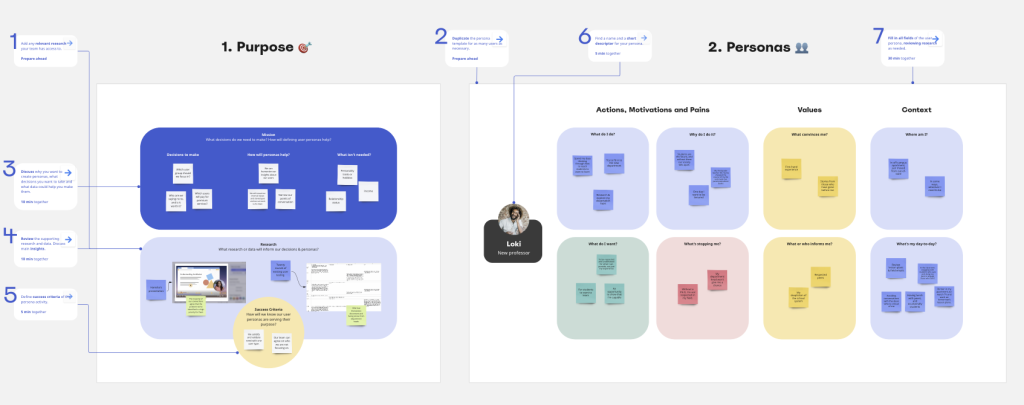If you’re running a business, then you know that understanding your customers is key to your success. But how can you understand your customers without talking to them? One way to get a better understanding of your customers is through user personas. In this blog post, we’ll discuss what user personas are, how to create them, and why they matter. We’ll also provide some persona examples for you to reference. Let’s get started!
What is a user persona?
A user persona is a semi-fictional character that represents a specific type of user that might use your product or service. Personas are based on real data and research about your users. Creating a persona can help you to better understand your users’ needs, motivations, and goals. User personas are important because they can help you to understand your users better. By understanding your users, you can create a better user experience for them. Additionally, personas can help you to target your marketing efforts and make sure that you’re reaching the right people.
How to create a user persona
There are a few different ways that you can go about creating a persona. One way is to use a persona template. This can be helpful if you’re just getting started with personas and need some guidance on what information to include. Another way to create a persona is to use the User Persona Canvas. This canvas includes prompts for all of the essential information that should be included in a persona.
What to include in a user persona

When you’re creating a persona, there are a few key pieces of information that you’ll want to include.
Demographics
This is the basic information about your persona, such as their age, gender, location, etc. What is the persona’s background? What are their education and work experience?
Goals
What are the persona’s goals? What do they hope to achieve by using your product or service? As an example of a goal, a persona might want to save time or money while using your product.
Frustrations
What are the persona’s frustrations? What pain points do they have that your product or service can help to solve? For example, a persona might be frustrated with the current options for your product or service or find that it’s too expensive.
Use cases
What are some specific use cases for your persona? When and how would they use your product or service? There could be different use cases for different persona, so it’s important to consider each persona individually. For example, if your persona wants to travel, they might use your service to book a flight or find a hotel. canvas with information about your
The process
Step 1: Define your research goals
Before you start creating your persona, it’s important to define your research goals. What do you hope to learn about your persona? This will help to guide the creation of your persona and ensure that you’re including all of the relevant information.
Step 2: Identify your target audience
Who are you trying to reach with your persona? Once you’ve identified your target audience, you can start to gather information about them. This can be done through surveys, interviews, focus groups, or secondary research.
Step 3: Create a persona template
Once you have all of the information that you need, it’s time to create your persona. As we mentioned before, one way to do this is by using a persona template. This will help to ensure that you’re including all of the relevant information in your persona.
If you want to get a little more creative with your persona, you can use the User Persona Canvas. This canvas includes prompts for all of the essential information that should be included in a persona.

We could recommend you to use Miro Persona Template of Semrush Persona Builder
Step 4: Find or create some real data
When you’re creating your persona, it’s important to use real data whenever possible. This could be data that you’ve gathered yourself through surveys or interviews. Alternatively, you can find persona examples online from other companies or organizations.
Step 5: Fill out the template
Once you have all of the information that you need, it’s time to create your persona. As we mentioned before, one way to do this is by using a persona template. This will help to ensure that you’re including all of the relevant information in your persona.
Step 6: Review and revise
After you’ve created your persona, it’s important to review and revise it. Make sure that all of the information is accurate and up-to-date. Additionally, consider whether there is any additional information that you could include.
Examples of user persona
Now that you know how to create a persona, let’s take a look at some persona examples.
The college student

Name: Sarah
Demographics:
- College student
- 18 years old
- Female
Background:
- Attends a large university in the United States
- Lives in a dorm on campus
Goals:
- To find a part-time job that is convenient and flexible around her class schedule
- To make some extra money to help pay for tuition and textbooks
Frustrations:
- Jobs that are available to her are often low-paying and do not offer flexible hours
- She does not have a lot of work experience, so it is difficult to find a job
Use cases:
- Uses Indeed or another job search engine to find part-time jobs in her area
- Applies for jobs that she is qualified for
- Follows up with potential employers after submitting her application
The stay-at-home mom

Name: Jenna
Demographics:
- Stay-at-home mom
- 33 years old
- Female
Background:
- Has two young children at home
- Husband works full-time
Goals:
- To find a way to make money from home so that she can stay at home with her children
- To find a flexible job that will allow her to work around her children’s schedules
Frustrations:
- Many of the jobs that she has found require her to work set hours, which are often during the day when her children are home from school
- She has not been able to find a job that pays well and also offers flexible hours
Use cases:
- Uses Indeed or another job search engine to find work-from-home jobs in her area
- Applies for jobs that she is qualified for
- Follows up with potential employers after submitting her application
The busy professional

Name: Alex
Demographics:
- Busy professional
- 38 years old
- Male
Background:
- Works a full-time job in an office
- Has a family with two young children
Goals:
- To find a way to make extra money without having to put in a lot of extra hours
- To find a job that is convenient and can be done from home
Frustrations:
- Many of the jobs that he has found require him to work set hours, which are often during the day when he is working his full-time job
- He does not have a lot of time to dedicate to a side job
Use cases:
- Uses Indeed or another job search engine to find part-time jobs in his area
- Applies for jobs that he is qualified for
Conclusion
As you can see, user personas can be extremely helpful in a number of different ways. By taking the time to create a persona for your target user, you’ll be able to make better decisions about your product or service. Additionally, you’ll be able to more effectively market to your target user. If you’re not sure where to start, there are plenty of persona examples and persona templates available online.
Photo by Christopher Campbell on Unsplash









